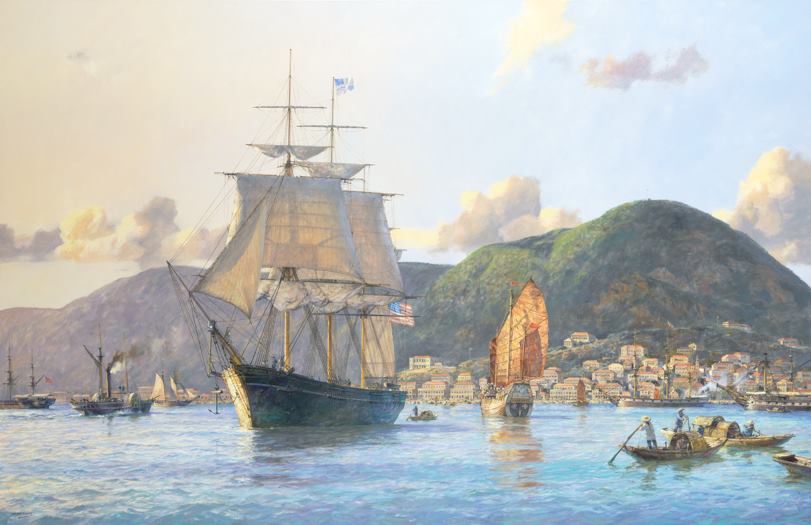1
/
of
1
Art Marine
Sea Witch in Hong Kong Harbour, 1849 - Commissioned oil on canvas by Geoff Hunt RSMA.
Sea Witch in Hong Kong Harbour, 1849 - Commissioned oil on canvas by Geoff Hunt RSMA.
Regular price
£0.00 GBP
Regular price
Sale price
£0.00 GBP
Unit price
/
per
Shipping calculated at checkout.
Couldn't load pickup availability
"Hong Kong harbour in 1849, clipper Sea Witch arriving at dawn"
Oil on linen canvas, 55 x 85 inches
The details in this large painting depicting the city of Hong Kong in 1849, as viewed from the anchorage, can best be described by proceeding from left to right.
Far left: the stern of a British merchant ship of the finest type, sometimes called 'Blackwall frigates'.
The paddle-steamer: these were early days for steam, but already there were many paddle steamers at work all round the world, and some of these can be seen in early paintings of Hong Kong, though I do not have a specific identity for this one. Unusually to modern eyes, these vessels often placed their paddle-wheels well aft of the centre, and the funnel even further aft (I built a small model to obtain a correct view of this peculiar arrangement ). Beyond her is a topsail schooner making her way towards the city wharves.
The city background: Hong Kong was a boom town, built from nothing to this extent in just two or three years. There are no photographs contemporary to 1849 but two or three good artists worked on site at this time and have left us a clear indication of the type of buildings, as well as some idea of the town's size. The most notable features are the large and very handsome merchant 'factories' lining the waterfront. The prominent building on a rise immediately to the right of Sea Witch is the official residence, Flagstaff House, which survives.
The American clipper Sea Witch: this ship held, and for that matter holds to this day, the record for the fastest passage under sail from Hong Kong to New York. Built in New York in 1846, she is seen here under the house flag of Howland and Aspinwall. Sea Witch had a career of only ten years and there is no known photograph of her, though there is one contemporary painting in the Peabody Museum, Salem, and also a lines plan and a sail plan. She is known to have carried the rather odd figurehead of a Chinese dragon, black, but there seems to have been a minor fashion at the time for these kind of outlandish subjects, and the contemporary Dreadnought, which had just such a figurehead, and of which a photograph does survive, shows that a New York shipbuilder's idea of a Chinese dragon looks very much like a large crocodile with bat's wings. She is shown here arriving in port, rounding up into the wind before letting go her anchors.
Foochow stock junk (right of centre): this traditional type of junk was ubiquitous. The stern was always heavily decorated, and the iconography was very specific, featuring a yen bird (because it was thought to be fast and unaffected by storms), together with dragons, flowers, representations of the eight immortals, and characters signifying long life and prosperity. To the right of this junk is another with a red-tanned sail in the distance: this is included to mark the approximate location where the American Club's building now stands.
The two ships to the right are, left, the American ship Montauk, flying the house flag of Wetmore & Cryder. Unusually for an American ship, she was painted with a white stripe and 'painted ports', which were black painted squares designed to give the impression of gunports from a distance, and so deter pirates; very commonly seen throughout the nineteenth century on British ships, and on many sailing ships to this day! The ship's extreme right also has black gunports, but these ones are genuine, for she is a British frigate, the Maender. In port for an extended stay, perhaps serving as a guardship, she has her topmasts sent down, jibboom housed, and awnings stretched over the decks. ( I do not know for sure that either Montauk or Maender were actually in Hong Kong or together at this time, but Montauk was certainly trading on this run, and Maender served a long commission in the immediate area, so it is reasonably likely).
Foreground right, sampans: the ubiquitous sampan, little changed for hundreds of years. The boatman on the foremost sampan is using the yuloh, the balanced single sculling oar; beyond, another boatman is using twin pushing oars. © Geoff Hunt 2015
Share


